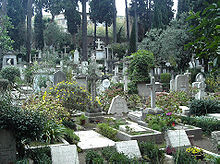Cimitero acattolico
 |
|
| Details | |
|---|---|
| Established | 1716 |
| Location | Rome |
| Country | Italy |
| Coordinates | 41°52′34″N 12°28′48″E / 41.876°N 12.480°ECoordinates: 41°52′34″N 12°28′48″E / 41.876°N 12.480°E |
| Type | Public |
| Style | 18th–19th century European |
The Cimitero Acattolico ("Non-Catholic Cemetery") of Rome, often referred to as the Cimitero dei protestanti ("Protestant Cemetery") or Cimitero degli Inglesi ("Englishmen's Cemetery"), is a public cemetery in the rione of Testaccio in Rome. It is near Porta San Paolo and adjacent to the Pyramid of Cestius, a small-scale Egyptian-style pyramid built in 30 BC as a tomb and later incorporated into the section of the Aurelian Walls that borders the cemetery. It has Mediterranean cypress, pomegranate and other trees, and a grassy meadow. It is the final resting place of non-Catholics including but not exclusive to Protestants or British people. The earliest known burial is that of a University of Oxford student named Langton in 1738. The English poets John Keats and Percy Bysshe Shelley are buried there.
Keats died in Rome of tuberculosis at the age of 25, and is buried in the cemetery. His epitaph, which does not mention him by name, is by his friends Joseph Severn and Charles Armitage Brown, and reads:
This grave contains all that was mortal, of a young English poet, who on his death bed, in the bitterness of his heart, at the malicious power of his enemies, desired these words to be engraven on his tombstone: Here lies one whose name was writ in water.
Shelley, who did not know how to swim, drowned in 1822 while sailing in his yacht off the Italian Riviera. When his body washed up upon the shore, a copy of Keats' poetry was discovered in his pocket - doubled back - as though it had been put away in a hurry. He was cremated on the beach near Viareggio by his friends, the poet Lord Byron and the English adventurer Edward John Trelawny. His ashes were sent to the British consulate in Rome, who had them interred in the Protestant Cemetery some months later.
...
Wikipedia
